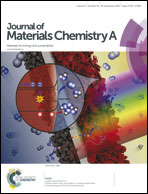Highly simple and rapid synthesis of ultrathin gold nanowires with (111)-dominant facets and enhanced electrocatalytic properties†
Abstract
One-dimensional (1D) Au nanowires with narrow diameters and high aspect ratios have attracted increasing attention because of their distinctive physicochemical properties and extensive applications. Despite significant advancements in the synthesis of 1D Au nanowires, many of the early reported synthetic strategies usually involve complicated procedures and commonly produce Au nanowires with large diameters, low aspect ratios and low yields. Herein, we report a feasible α-naphthol-assisted preparation of ultrathin Au nanowires with an extremely rapid reaction rate (completed in ∼1 min) under moderate conditions. The resultant Au nanowires possess a Boerdijk–Coxeter helix-structured morphology dominated by (111) facets. The rapid coordination-induced formation of Au nanowire-arrayed microspheres and their gradual dissociation account for the formation of ultrathin Au nanowires. Due to the 1D anisotropy, plentiful surface atoms and abundant structural defects, these ultrathin Au nanowires exhibit outstanding electrocatalytic performance toward the oxygen reduction reaction (ORR) with boosted activity, durability and alcohol resistance compared to Au nanowire-arrayed microspheres, Au nanoparticles and a commercial Pt black catalyst. The present work provides a novel perspective for synthesis of ultrathin Au nanowires with various promising applications.



 Please wait while we load your content...
Please wait while we load your content...